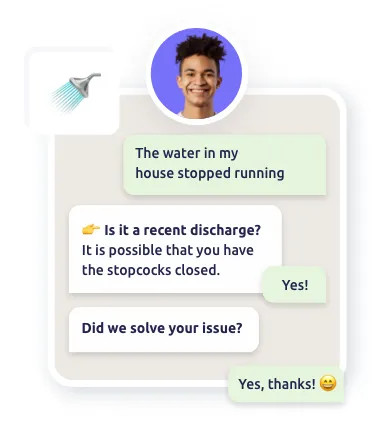Conversational AI
AI technologies combined to deliver effective conversations and interactions

Boost your business interaction with AI-powered chatbots
Boost your marketing strategy with WhatsApp templates
Offer immediate and personalised contact to your customers, boost real-time communication.
Optimise your customer service with our Ticketing Automation solution.
Automate, manage and improve your team’s efficiency with internal chatbots/helpdesk
Boost business growth by analysing performance and assessing efficiency
AI technologies combined for effective cross-channel conversations
Integrates GPT to further enrich customer conversations
Customer service
Marketing
Sales
Ecommerce
Services
Tourism
Logistics
Banking
Insurance
Telco
Public Administrations
Health
Restoration
Success stories
About us
Contact
Partners
Prices
Blog
Premium Content
ROI calculator

COMPANIES THAT ALREADY TRUST AUNOA














can be complex… so we have designed a solution to simplify this process!
Conversational Artificial Intelligence solutions that allow you to go beyond automated responses to frequently asked questions.
The conversational channels most used by your customers to help you be where your customers are.
Different AI technologies so the communication with your customers is through conversations, fluid and automated.
Conversational artificial intelligence is the combination of natural language processing and machine learning, and it has the goal of generating human-like conversations in conversational channels.
We merge commercial generative AI models (OpenAI, Google and Antrophic), with our own models to lead the generative AI revolution.
Identifies through voice or text the intent and context of a query. This includes words, grammar, semantics and different ways of asking the same question.

Proposes suggestions to ambiguous questions when the comprehension rate is not optimal, ensuring a smooth conversation.

Evaluates different answer alternatives according to the percentage of understanding and selects the best one to solve the question correctly.

History of unidentified questions and unresolved queries, used to improve responsiveness and performance.

+200K
users per month
80%
automation
+4M
messages per month
+250K
of conversations per month

NLP models allow AI chatbots to exchange messages that imitate the naturalness of a human conversation and, thanks to the training of our specialized team, you can ensure continuous improvement.
AI models can be adjusted to different languages, expressions and regionalisms.
Chatbots have the ability to identify orthotypographic mistakes and synonyms.
Emojis and voice messages enable humanizing experiences and messaging.
Personalized expressions to humanize conversations.
CONTINUOUS TRAINING
Conversational chatbots can be very beneficial, yes, indeed, they are effective! Continuous training and human supervision of AI chatbots ensures effective, less robotic conversations.
Our goal is to ensure continuous improvement through Supervised Conversational AI, knowledge base growth and proactivity in relation to user demands.


AI monitoring allows us to identify queries that are not in the Knowledge Base with the objective of increasing the model and achieving automation ratios above 90%.
Review of unresolved queries, correcting possible false positives or false negatives by retraining the system.
Analysis of the states most used by users to enrich the NPL of the model with different ways of performing the same query.
Verification of the degrees of confidence obtained in the NLP answers.
Evaluate the Live Chat conversations to identify points of improvement and growth for the Knowledge Base.
How it increased Customer Service Agent productivity by 230%
“Aunoa’s software has been helping us provide solutions that align with our customers’ needs.” This allows us to facilitate a quick response, shorten waiting times and eliminate potential frustrations, which is vital to the shopping experience”.

MIGUEL VILLAR
CUSTOMER SERVICE MANAGER
All about chatbots and ChatGPT. Find out how conversational AI redefines conversations. Explore the future of interaction!